Thinking about an open concept home renovation? Tearing down walls and creating a seamless, airy flow can completely transform your living space. When we renovated our home, the biggest challenge was balancing an open feel with functional zones. A well-planned open concept home renovation can make even a small space feel expansive while improving natural light and connectivity.
Whether you’re removing a non-load-bearing wall or redesigning the entire layout, thoughtful planning is key. From choosing the right flooring to creating visual boundaries with furniture, every detail matters in an open concept home renovation.
A successful open concept home renovation blends aesthetics with functionality. Structural considerations, smart storage solutions, and cohesive design choices ensure the space remains practical and inviting. Open floor plans are perfect for entertaining but require careful attention to lighting and acoustics.
Without proper zoning, an open concept home renovation can feel overwhelming rather than welcoming. Whether you’re updating a kitchen-living combo or integrating a dining area, these open concept home renovation ideas will help you create a stylish, cohesive space that feels both modern and livable.
Maximize Natural Light
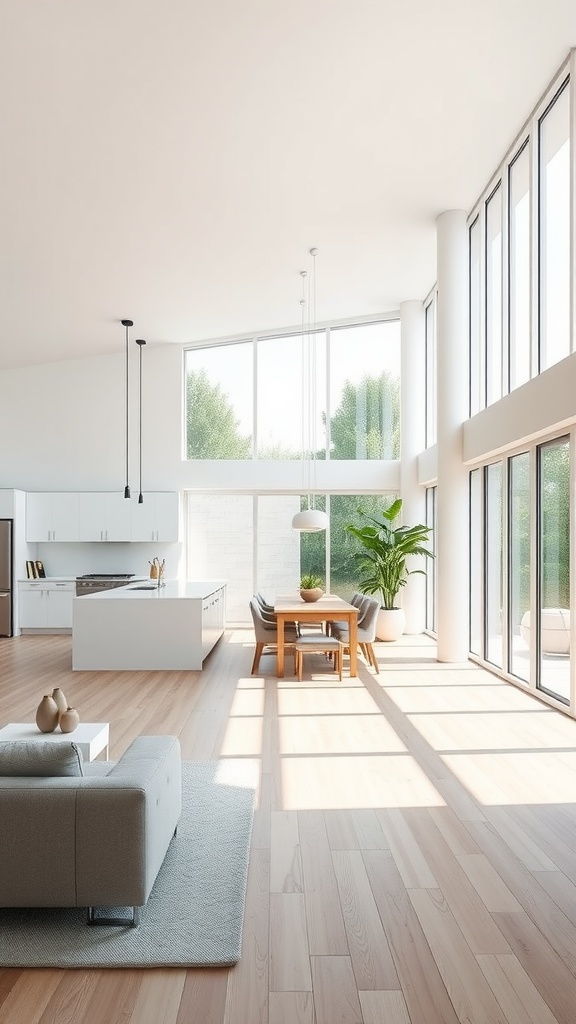
When I think about transforming a space, maximizing natural light always comes to mind. Just take a look at this beautifully open concept living area. The large windows invite so much light in, creating a warm and welcoming atmosphere. I’ve learned that natural light can make a space feel bigger and brighter, which is a huge plus in any home renovation.
One of my favorite aspects of this design is how the sunlight dances across the wooden floors. It reminds me of mornings spent sipping coffee while enjoying the view outside. Incorporating light-colored walls and furniture, like in this image, enhances the effect even further. I’ve noticed that lighter tones can reflect sunlight, making the room feel airy.
Don’t forget about the layout! An open space, as shown here, allows light to flow freely from one area to another. I’ve found that removing unnecessary walls can create a more open feel. If you’re considering renovations, think about how you can open up your space to let in more light!
Lastly, adding plants, as seen in the corner, not only beautifies the room but also adds to the natural vibe. I love placing greenery near windows where they can soak up that sunlight, making the entire area feel more alive.
Use A Neutral Color Palette
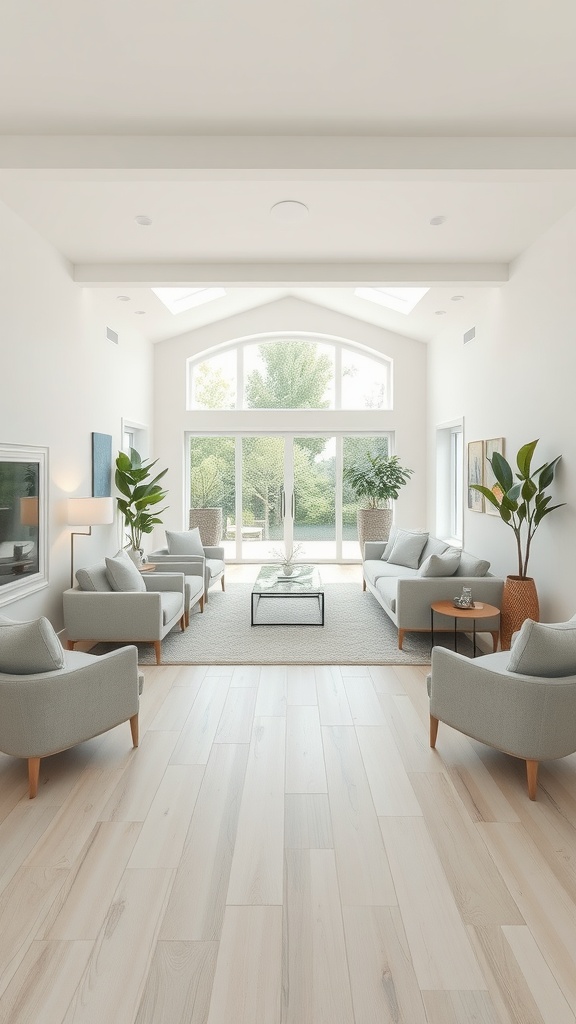
When I decided to renovate my open-concept space, choosing a neutral color palette felt like the right move. The image above captures a serene setting that truly illustrates the beauty of these tones. With soft greys, whites, and natural elements, this room invites relaxation and comfort.
Using a neutral palette allows for versatility. I love how it lets the natural light flow through the space. The large windows in the image not only bring in sunlight but also highlight the light colors, making the area feel airy and open. It’s a perfect example of how neutrals can enhance the feeling of spaciousness.
In my experience, adding a few pops of color through decor or plants can break up the monotony without overwhelming the senses. The greenery in the image adds that perfect touch, bringing life into the neutral tones. I’ve found that incorporating plants not only beautifies the space but also promotes a fresh atmosphere.
Lastly, I suggest considering texture along with color. The flooring and soft furnishings in the image showcase how different materials can add depth. I’ve added a cozy rug and some textured cushions in my own living area, which really brings everything together!
Define Spaces With Rugs
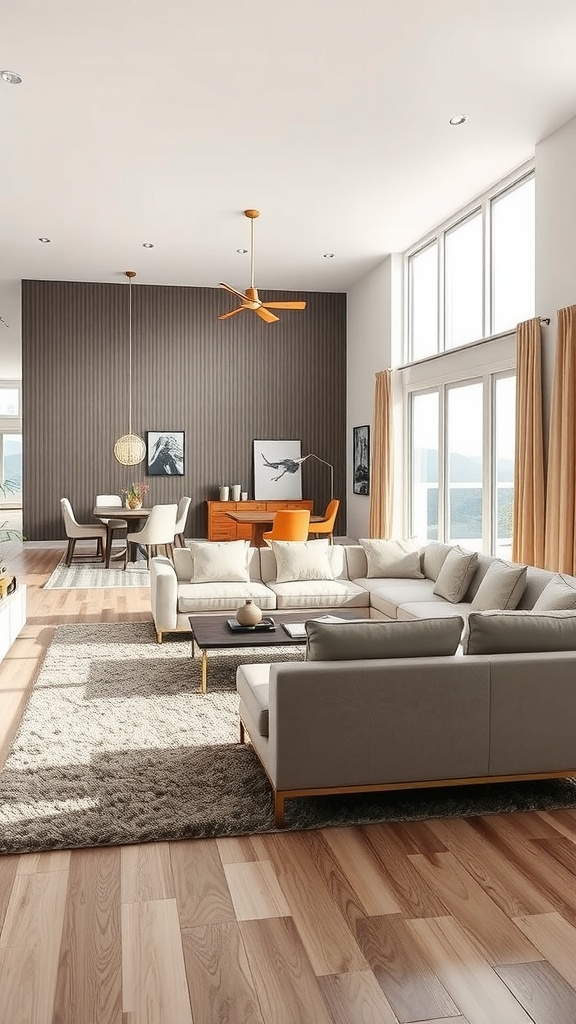
When I first moved into my open concept home, I found it a bit overwhelming. The vastness of the space made it hard to define areas for different activities. Then I discovered the magic of rugs. Just like in the image, a well-placed rug can really help to delineate spaces without building walls.
In the photo, the soft, plush rug under the seating area invites you to sink into the couch and relax. It creates a cozy feeling that’s perfect for gatherings or family movie nights. I remember when I added a similar rug to my living room; it instantly made the space feel warmer and more inviting.
Rugs can also play a significant role in adding a pop of color or texture to your home. In this image, the rug complements the neutral tones of the furniture while subtly contrasting with the wooden floor. I love how a rug can tie together various design elements, making everything feel cohesive.
Another thing I learned is that rugs help with sound absorption, making an open space feel quieter and more intimate. I added a thick rug, and it made a noticeable difference in the overall ambiance. So, if you’re looking to define spaces in your open concept home, consider adding rugs. They’re practical, stylish, and they can completely transform the vibe of a room.
Install A Large Kitchen Island
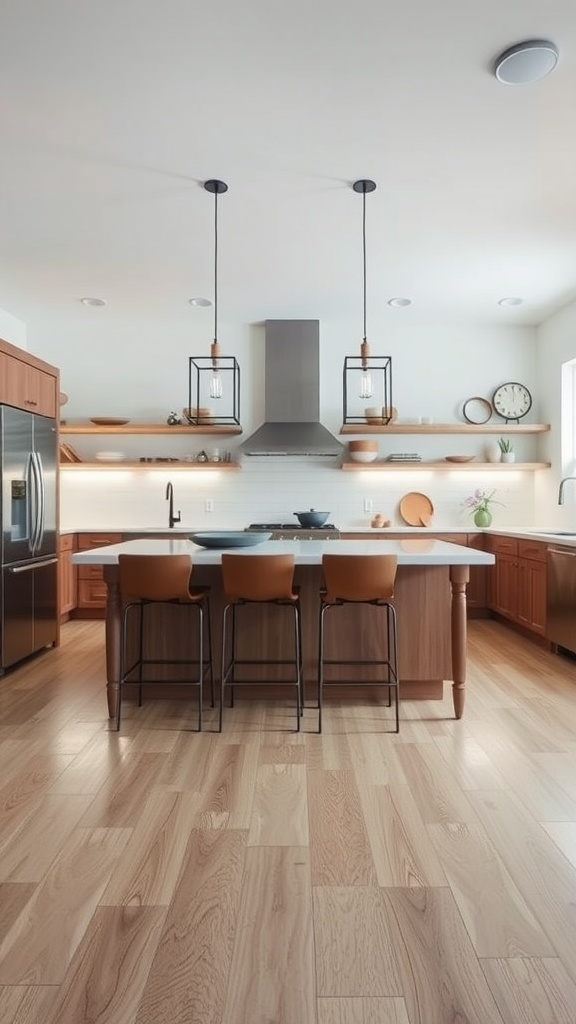
When I think about the heart of the home, my mind goes straight to the kitchen. A large kitchen island is not just a place to prep meals; it transforms the entire space. I remember when we decided to install ours; it felt like we were adding a new member to the family!
This particular kitchen island showcases a clean, modern design with a spacious countertop that invites gatherings. I love how the two bar stools offer a cozy spot to enjoy morning coffee or help kids with homework. The warm wood tones of the cabinetry pair beautifully with the sleek island, creating a balance that feels inviting.
One thing we noticed is that the island also serves as additional storage. We added some baskets underneath for fruits and vegetables, which keep things organized and easily accessible. It’s a smart way to maximize space while keeping the kitchen functional.
Lighting is another key element. The pendant lights hanging above the island not only provide necessary brightness but also add a stylish touch. Whenever we have friends over, those lights create the perfect atmosphere for conversation and laughter. I can’t help but feel that the island has become a central gathering spot in our home.
Incorporating a large kitchen island is a decision I’d recommend to anyone considering an open concept renovation. It’s not just about aesthetics; it truly enhances how you use the space. Whether you’re cooking, entertaining, or just hanging out, a kitchen island makes it all feel more connected.
Choose Consistent Flooring

When I first started planning our open concept home renovation, I quickly realized how important flooring would be. The image captured here perfectly illustrates this point. The seamless transition from the kitchen to the dining area creates a unified look that makes the space feel larger and more inviting.
In our own experience, we chose a light wood flooring that not only brightens the room but also complements our furniture and decor. It’s essential to pick flooring that ties together different areas, especially in an open layout. This consistency can really influence the mood of the home.
We also learned that mixing different flooring types can create a disjointed feel. In our renovation, we avoided that by selecting a single type of flooring that flowed throughout the main spaces. It helped create a harmonious look that we absolutely love. The natural wood grain adds warmth and character without overwhelming the space.
Choosing consistent flooring isn’t just about aesthetics; it can also make cleaning easier. I can’t tell you how much simpler it is to sweep and mop without worrying about different materials. It’s all about making life a bit easier while enhancing the visual appeal.
So, if you’re considering an open concept renovation, remember to keep your flooring consistent. It will tie everything together beautifully, just like in the image, and create a welcoming atmosphere that you and your guests will appreciate.
Use Partial Dividers

When I first started my open concept home renovation, I quickly realized that creating distinct areas without closing things off completely was a challenge. That’s when I discovered the beauty of partial dividers. The image here perfectly illustrates this idea. The wooden slats not only add a touch of style, but they also define the dining area from the living space without obstructing the flow of light and sight.
In my own experience, using partial dividers can make a big difference. They bring a sense of organization and clarity to an open layout while keeping the areas connected. I remember how awkward my space felt before; now, with some strategically placed dividers, it feels more inviting and purposeful.
Plus, you can get creative with materials. While wood is a classic choice, I’ve seen people use glass, metal, or even fabric to create a unique look. In my case, I opted for a simple wood finish that complements the rest of my decor. If you’re feeling crafty, you could even build your own! It’s a fun way to add personal flair while ensuring that your home remains functional.
Opt For Open Shelving
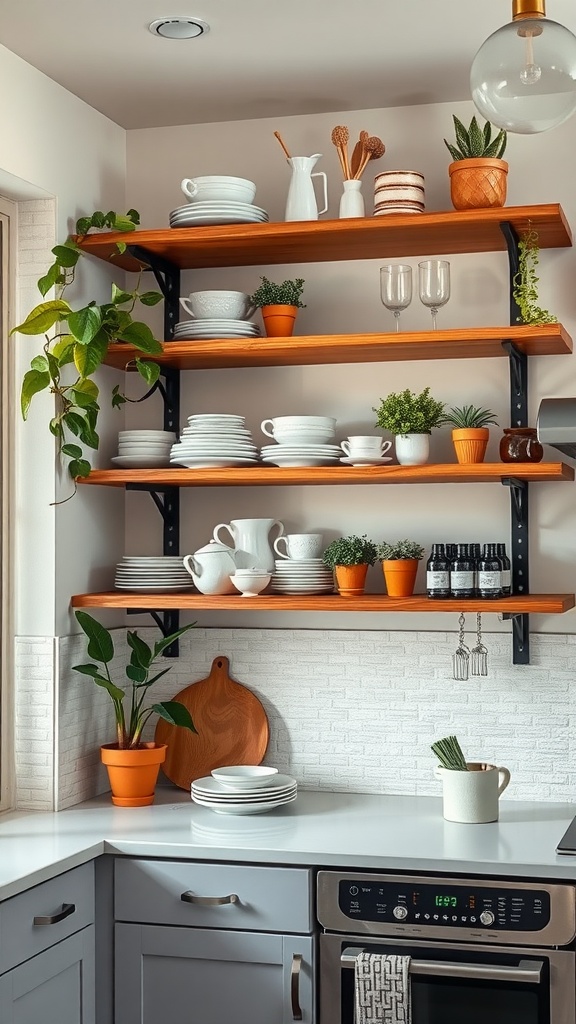
When I decided to go for an open shelving concept in my kitchen, it really transformed the space. The image above captures the essence of what I aimed for: functionality meets aesthetics. The combination of wooden shelves and simple white dishes creates a cozy yet modern vibe.
Open shelving not only provides easy access to your favorite items, but it also encourages creativity in how you display them. I’ve found that mixing in a few plants and colorful pots, like those seen here, brings life to the area and adds a personal touch.
Plus, it makes for a great conversation starter when friends come over. Everyone loves to admire how I’ve arranged my kitchenware and greenery. It’s a simple way to showcase my personality while keeping everything within reach.
Another benefit I’ve experienced is that I’ve become more organized. Without the confines of traditional cabinets, I’m more mindful about what I keep on display. If something doesn’t fit the look or isn’t used often, it gets tucked away or donated. The result? A clean, open feel that makes cooking much more enjoyable.
Create Zones With Ceiling Treatments
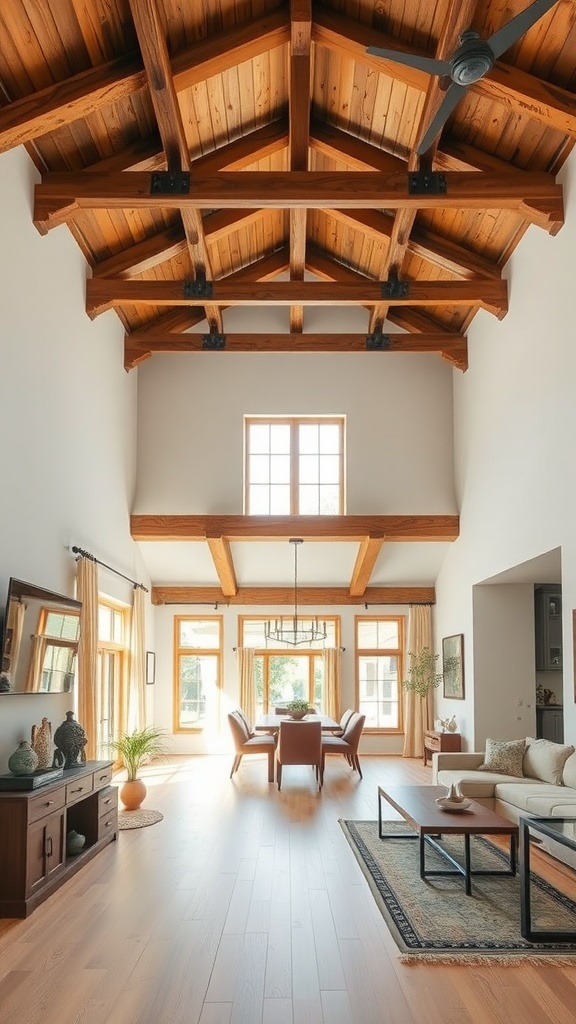
In open concept homes, defining spaces can be a bit of a challenge. One method I’ve found really effective is using ceiling treatments to create distinct zones. Just like in the image, where the beautiful wooden beams draw the eye upward, they help to visually separate the dining area from the living space.
When we renovated our own home, we added a coffered ceiling in the dining room. It not only looked stylish but also made the area feel more intimate, even in a large open layout. The difference was noticeable! I remember how we used to struggle with having a single, sprawling space that felt disconnected. By adding ceiling design elements, we transformed it into inviting zones.
Another idea is to play with paint or wallpaper on the ceiling. I’ve seen some folks use a bold color or a fun pattern to mark off an area. It’s a simple way to make a statement without overwhelming the room. In the living room, keeping the ceiling light and airy while going darker in the dining area can also give a nice contrast.
Incorporating lighting fixtures, like chandeliers or pendant lights, can also help delineate spaces. We hung a beautiful chandelier above our dining table that not only serves a practical purpose but also adds character to the zoning.
Add Sliding Glass Doors
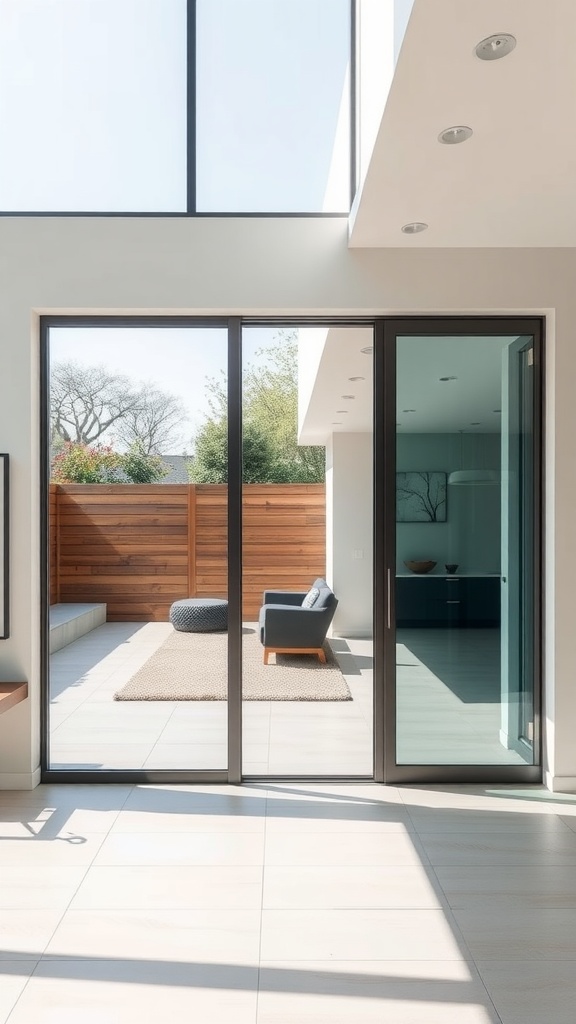
When I think about transforming a space, adding sliding glass doors comes to mind right away. They serve as a bridge between your indoor and outdoor areas, allowing natural light to flood in while creating a seamless transition. In the image, you can see how these doors open up the room, making it feel more expansive and airy.
I remember when we installed sliding glass doors in our home. The transformation was immediate. It not only brightened our living area but also gave us easier access to our backyard. We host gatherings, and having the doors open made it feel like the party flowed naturally between indoors and outdoors.
These doors are not just practical; they also add a modern touch to your decor. The sleek design can match various architectural styles, enhancing the overall appeal of your home. Plus, on those beautiful sunny days, being able to step outside with ease is such a joy. We love having coffee on the patio, just a few steps away from our living room.
Another bonus is the energy efficiency sliding glass doors can offer. Many models are designed with insulation features that help maintain your home’s temperature. This can be a game changer in terms of energy bills. So, if you’re considering a renovation, think about how these doors can make your space feel larger, brighter, and more connected to nature.
Utilize Built-In Storage
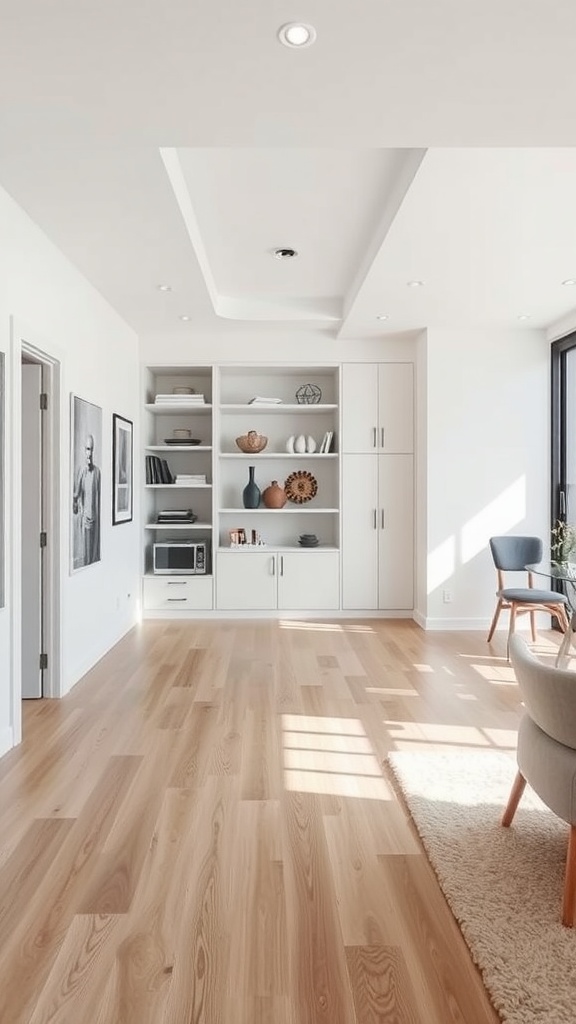
When it comes to open concept homes, maximizing space can feel like a challenge. I found that incorporating built-in storage is one of the simplest and most effective ways to keep things organized while still looking stylish. Looking at the image, you can see how the built-in shelves blend seamlessly with the overall design. This not only saves space but also adds a touch of elegance to the room.
In my own home, I decided to create built-in cabinets around a wall to store books, knick-knacks, and even some less attractive kitchen appliances. It has made a world of difference! Instead of clutter, I have a streamlined look that feels both functional and appealing.
Additionally, I love how built-in storage can showcase personal items. The shelves in the image hold a mix of decorative pieces and practical items, which makes the room feel lived-in and welcoming. I rearrange my display to keep things fresh, and it’s fun to highlight different treasures from my travels or family heirlooms.
When planning your own built-in storage, consider what you want to store and how you want it to look. Do you prefer open shelves for displaying items or closed cabinets for a clean look? Incorporating both can keep your space versatile and functional.
Keep Furniture Low-Profile
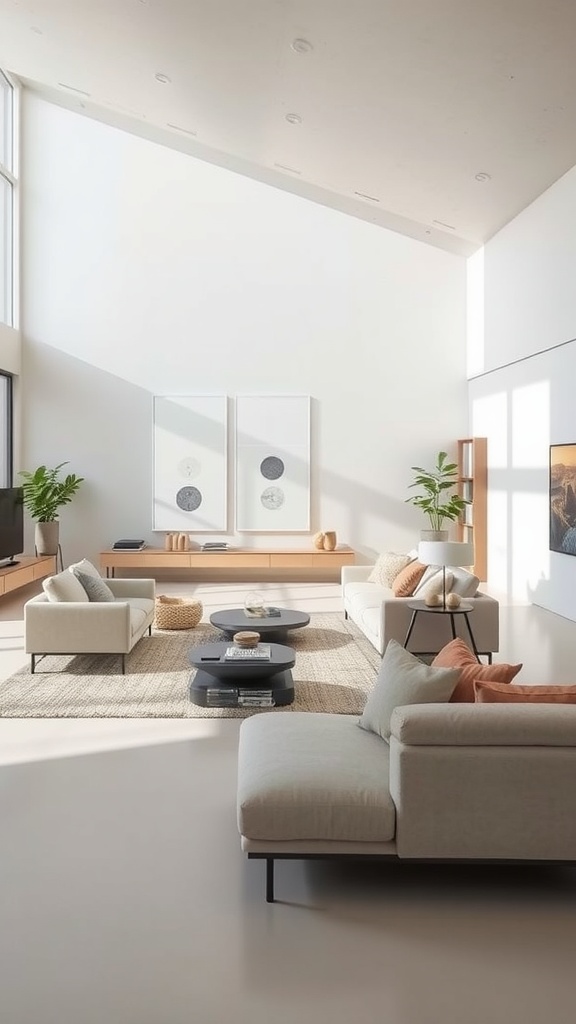
When I started my open concept home renovation, one of the first things I learned was the magic of low-profile furniture. If you look at this image, you’ll notice how the sofas and coffee table seamlessly blend into the space without overwhelming it.
This approach not only keeps the room feeling airy but also allows the large windows to shine. I’ve found that lower furniture creates a sense of openness that really makes a difference in how the space is perceived.
In my own living area, I opted for sleek, modern sofas with minimalistic design. It helped draw the eye upward, highlighting the beautiful high ceilings. Plus, the neutral tones give a calm vibe that complements the natural light pouring in.
One thing I love about low-profile pieces is how versatile they are. You can easily swap out pillows or throws to refresh the look without making any big changes. It’s all about keeping things simple yet stylish, allowing for easy transitions as seasons change.
So, if you’re planning your own renovation, consider going for furniture that sits lower. It can really enhance the flow of your open space, making it feel welcoming and spacious. Trust me; it’s a small tweak that can lead to a big change in ambiance!
Use Statement Lighting
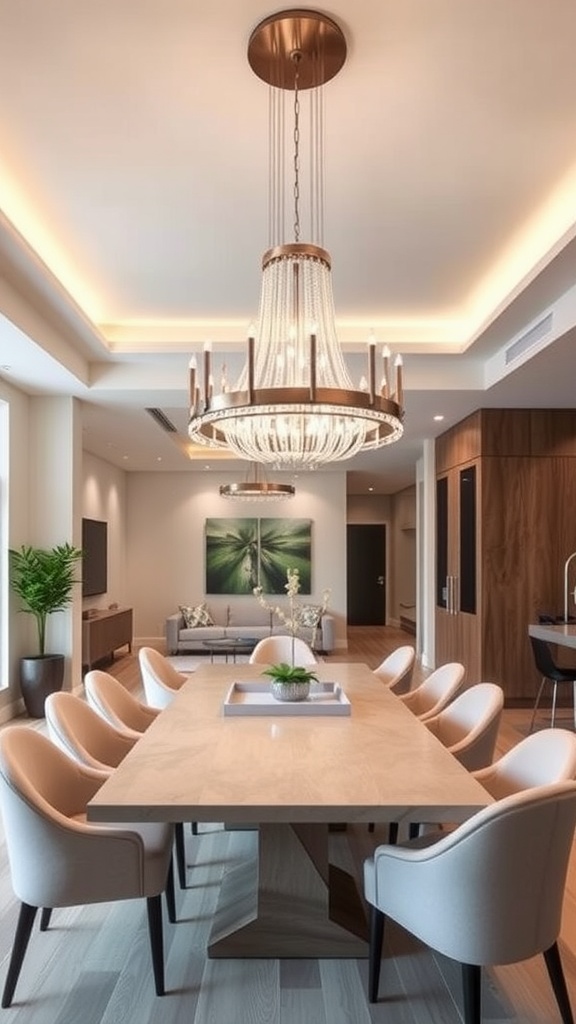
In my journey of home renovation, one of the biggest insights I’ve had is the power of statement lighting. Looking at the image, you can see how a stunning chandelier instantly elevates the dining space. It’s not just about illumination; it’s about creating a focal point that draws the eye and sets the mood.
A well-chosen light fixture can transform an open concept area, making it feel more inviting and stylish. When I chose a statement piece for my dining room, it became the heart of the space. Friends and family are always drawn to it during gatherings, sparking conversations and compliments.
Consider your personal style when selecting lighting. Whether you prefer modern, rustic, or something more eclectic, the right fixture can reflect that. I love how the chandelier in the image complements the sleek furniture and soft color palette, creating a cohesive look.
Don’t forget about layering light! Combining your statement piece with softer ambient lighting can make your space feel warm and welcoming. In my home, I added recessed lights and floor lamps, which work beautifully with the chandelier to provide versatility for different occasions.
Choose Multi-Functional Furniture
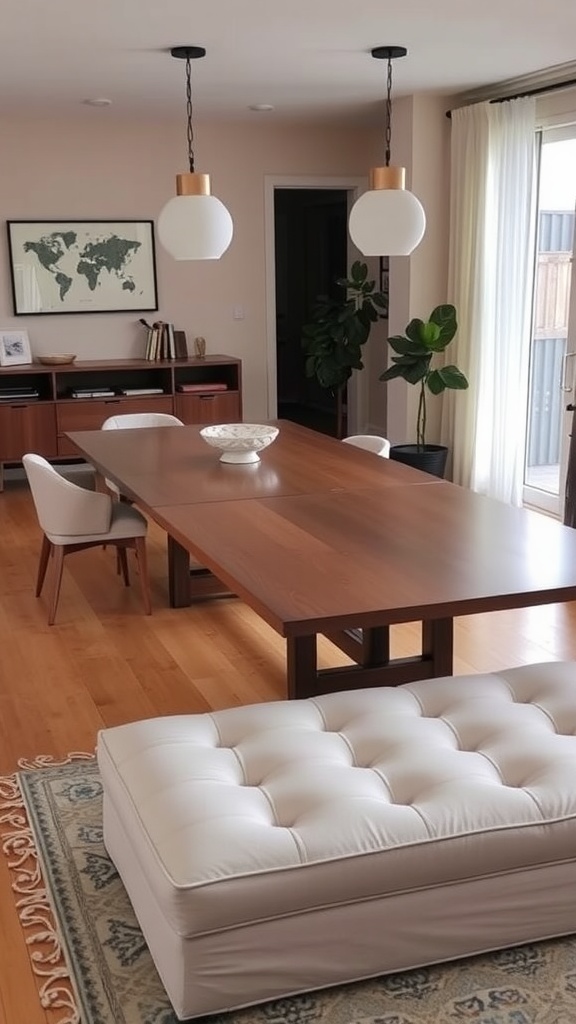
When I think about making an open concept home truly shine, choosing multi-functional furniture is key. In the image, you can see a spacious dining area with a large wooden table and some sleek chairs. But what really catches my attention is that stylish white ottoman. It’s not just a seat; it can double as a coffee table or even extra storage, which is so helpful in smaller spaces.
Having furniture that serves more than one purpose transforms the way we use our home. I remember when we set up our living area; we opted for a sofa bed. This allowed us to accommodate guests without cramping our space. Plus, it adds versatility to the room, making it feel more inviting.
In the photo, the lighting is also a highlight. Those pendant lights above the dining table create a warm atmosphere. This makes me think about how lighting can complement multi-functional furniture, enhancing both style and function.
Ultimately, choosing pieces that can adapt to different needs keeps our home feeling open and spacious. It’s all about maximizing what we have. So, whether it’s an ottoman that can be a table or a coffee table with hidden storage, make those choices count!
Integrate A Cohesive Color Scheme

When I started my open concept home renovation, one of the first things I learned was the importance of a cohesive color scheme. Just like in this image, where soft neutrals blend seamlessly with natural wood tones, a well-thought-out palette can create a tranquil and inviting space.
I remember standing in my living room, overwhelmed by the choices I had for colors. I decided to stick with warm earth tones that gave my home a cozy feel. The light wood floors paired beautifully with soft beige and muted greens. This strategy not only kept the area feeling spacious but also allowed each section to flow nicely into the next.
In this image, the colors are soothing and minimalistic, which makes the space feel calm. I think one of the key points is to choose a primary color and then two or three accent colors. For example, the subtle pops of color in the cushions or artwork can really tie everything together without being too overwhelming.
Don’t forget to consider the natural light in your space too! I made sure to test how different colors looked throughout the day. The way the sun interacts with the shades can change the entire vibe of the room. It’s all about finding a balance that works for you while creating a warm and inviting atmosphere.
Ultimately, integrating a cohesive color scheme is about expressing your style while making sure all elements of your home feel interconnected. Just like in the image, the right colors can transform a space into a harmonious haven.
Open Up The Entryway
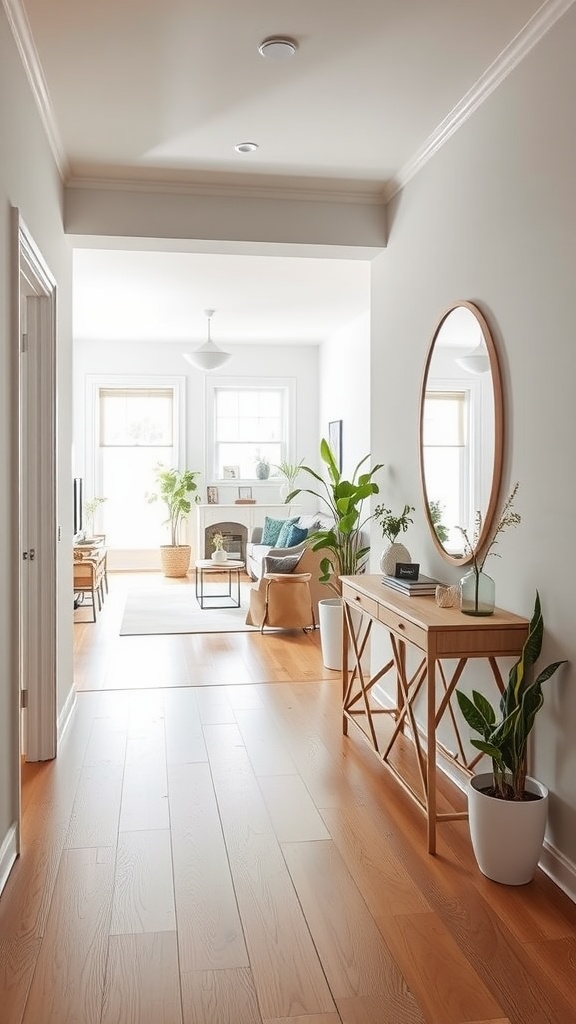
When I first looked at my entryway, I realized it was cramped and uninviting. Opening up this space made a world of difference in how my home feels. In the image, you can see a bright, airy entryway that perfectly connects to the rest of the home. That light wood flooring and soft color palette create a warm welcome.
One of the first things I did was remove any bulky furniture. With a sleek console table like the one in the picture, you get the functionality without the clutter. It’s a great spot to drop keys or display a couple of plants. Adding greenery can really liven up the space. I love how the plants in the image bring a touch of nature indoors.
Mirrors can also help in making the entryway feel larger. The round mirror in the image not only serves a purpose but also adds a decorative element. It reflects light and gives an illusion of more space. I found that placing a mirror opposite a window can really brighten up the whole area.
Lighting plays a crucial role, too. The pendant light in the picture is simple yet effective, bringing in just the right amount of illumination. I swapped out my old overhead lighting for something more modern, and it made the space feel more welcoming.
Finally, don’t forget about organization. A tidy entryway sets a positive tone for the rest of the house. I added some stylish hooks for bags and jackets, and it keeps everything looking organized. Opening up the entryway doesn’t just improve aesthetics; it creates an inviting atmosphere for both family and guests.
Use Reflective Surfaces
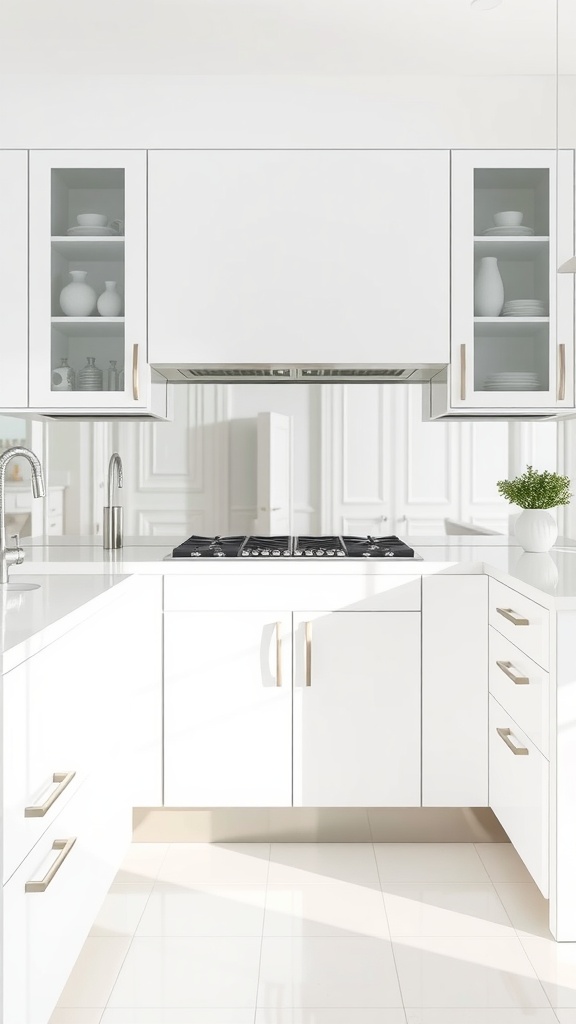
When I first started designing my open concept home, I quickly realized the importance of reflective surfaces. They can make a space feel larger and brighter, which is essential in an open layout.
In the kitchen, for example, I opted for white cabinetry and glossy countertops. Every time sunlight streams in, it bounces off these surfaces, illuminating the entire area. It’s like having a natural light source that enhances the space without needing more fixtures.
I also added a few glass elements, like cabinet doors. They not only showcase my dishware but also reflect light, creating a layered effect that adds depth to the room. I remember when guests commented on how airy my kitchen felt, and I realized it was all about those reflective surfaces.
In my experience, even small additions, like a mirrored backsplash or metallic accents, can significantly change the vibe of a room. They catch the light and draw the eye, making the areas feel more connected and inviting.
Incorporate A Feature Wall
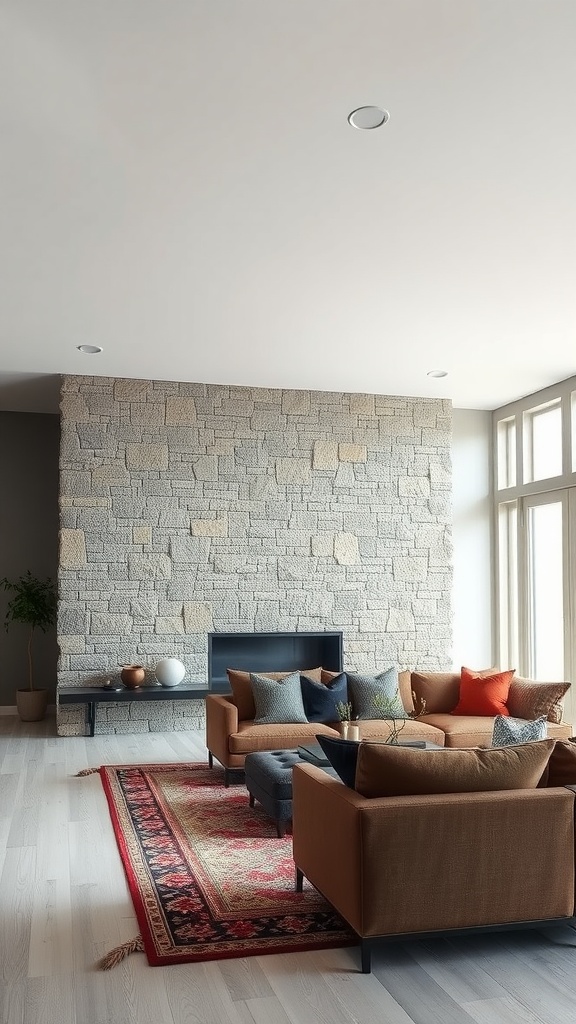
When I think about creating a cozy and inviting space, the first thing that comes to mind is a feature wall. In the image, the textured stone wall really draws the eye and adds depth to the room. It’s a great example of how a simple design choice can transform an entire area.
Feature walls can serve as a focal point that brings the whole room together. I remember when I decided to add a wood panel accent wall in my living room. It was a little daunting at first, but the warmth it brought was absolutely worth it. Just like in the image, using materials like stone or wood gives an organic feel that makes the space feel more grounded.
Choosing the right colors and textures is key. In the image, the neutral tones of the stone complement the brown and blue furniture beautifully. I’ve found that selecting a color palette that resonates with your personal style can enhance the overall ambiance. Don’t be afraid to mix materials, like pairing a soft rug with a rough stone wall.
Lastly, consider adding some decorative elements to your feature wall. In my home, I’ve hung some artwork and added a few plants that bring life to the wall. Just like those decorative touches in the image create a harmonious balance with the furniture, I believe that little details make a big difference in creating a space that feels truly yours.
Bring In Natural Elements

When I think of open concept living, the first thing that comes to mind is how to create a space that feels warm and inviting. One of my favorite ways to achieve this is by bringing in natural elements. The image above perfectly captures this idea with its lush greenery and wooden features.
As I look at the room, I can almost feel the fresh air flowing in from those large windows. The wooden beams on the ceiling add character and warmth, making the space feel less like a box and more like a home. I’ve found that incorporating natural materials like wood and stone can do wonders for creating a cozy atmosphere.
Plants are another fantastic element to include. In my own home, I’ve noticed a huge difference when I added a few potted plants to my living area. They not only purify the air but also bring a pop of color and life to the room. Just like in the image, a mix of different types of plants can create a serene and calming environment.
Using natural light is key as well. The way the sunlight filters through the windows in the image fills the space with a warm glow. I love to open my curtains wide and let the sunlight pour in; it instantly lifts my mood. Natural light can make any space feel larger and more inviting.
Lastly, the earthy color palette in the room complements the natural elements beautifully. Soft tones create a serene backdrop, allowing the greenery and wooden accents to shine. In my experience, choosing colors inspired by nature can tie the whole look together.
Ensure Proper Ventilation

When I think about open concept home renovations, one key element stands out: proper ventilation. The image above captures a bright and airy living space with high ceilings and large windows. This setup not only looks inviting but also plays a crucial role in airflow.
In my experience, having good ventilation is essential, especially in open areas. It helps maintain a comfortable temperature and keeps the air fresh. I remember when we renovated our own space. We added ceiling fans, just like those in the image, to enhance the circulation. They not only look stylish but also serve a practical purpose.
Also, consider the placement of windows and doors. In our home, we positioned them to create a natural cross-breeze. On warm days, it feels refreshing to let the outside air flow in. Adding plants, as seen in the image, can also improve air quality and create a more inviting atmosphere.
So, as you plan your renovation, think about how you can incorporate ventilation features. It’s not just about aesthetics; it’s about creating a space where you can breathe easy and feel comfortable.
Maintain A Minimalist Approach
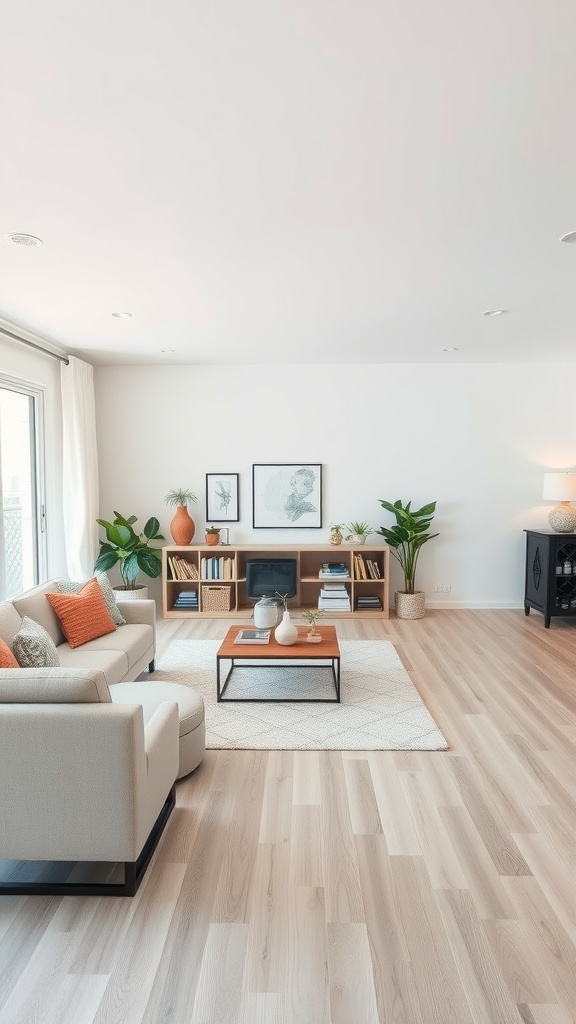
When I think about my open-concept home renovation, the first thing that comes to mind is keeping a minimalist vibe. This image captures that feeling perfectly: a simple yet inviting space that feels airy and organized. The light colors and spacious layout create a serene environment, which is exactly what I aimed for in my own home.
I remember the days when I had clutter everywhere, and now, seeing this clean design reminds me of how freeing it is to embrace minimalism. It’s all about choosing a few key pieces that really speak to you. The furniture in the image—like the cozy sofa and the stylish coffee table—adds warmth without overwhelming the space.
What I’ve found is that less really is more. I focused on keeping decor elements to a minimum while ensuring they serve a purpose. The plants in the corners not only add a touch of nature, but they also fill the space with life, which I love! It’s important to have a few focal points, like the artwork on the wall, that draw the eye but don’t crowd the room.
Moreover, having open spaces makes it easy to move around. I’ve noticed how this layout encourages social interactions. Friends and family can gather comfortably without feeling cramped. That’s what I wanted: a home that feels both spacious and inviting.
In summary, maintaining a minimalist approach in your open-concept area can transform your living space. Choose pieces that resonate with you, keep the clutter to a minimum, and create an atmosphere that feels both relaxing and welcoming.
Connect Indoor And Outdoor Spaces
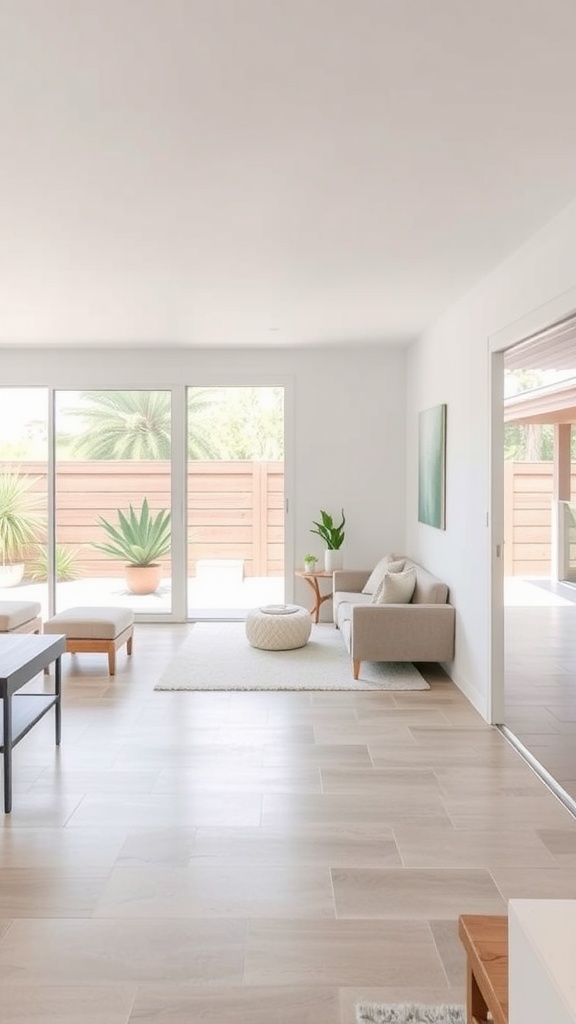
One of the best parts about open concept home renovations is how they can seamlessly blend indoor and outdoor spaces. When I renovated my living area, I aimed to create a flow that made it easy to transition from the comfort of my home to the beauty of the outdoors.
The image above is a perfect example of this concept. The large glass doors allow natural light to flood into the room, and the view of the backyard gives a sense of spaciousness. I remember the first time I opened those doors; it felt like the entire space expanded, inviting fresh air and sunshine right into my living room.
To achieve this connection, I recommend using materials that complement both environments. For instance, I chose similar flooring for both the interior and patio, and it really tied everything together. It gives a cohesive look that makes it feel like one large area.
Adding greenery, like the potted plants seen here, can also bridge the gap between the two spaces. I love how plants not only beautify the space but also create a more inviting atmosphere. It’s amazing how a few well-placed plants can draw the eye outdoors, encouraging a sense of harmony.
Finally, consider using furniture that works well in both settings. I found that having lightweight, stylish pieces made it easy to rearrange for gatherings, whether inside or outside. Connecting indoor and outdoor spaces has truly transformed the way I enjoy my home.


